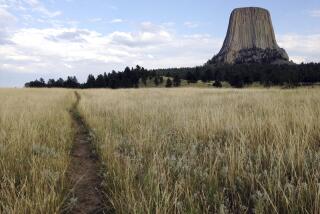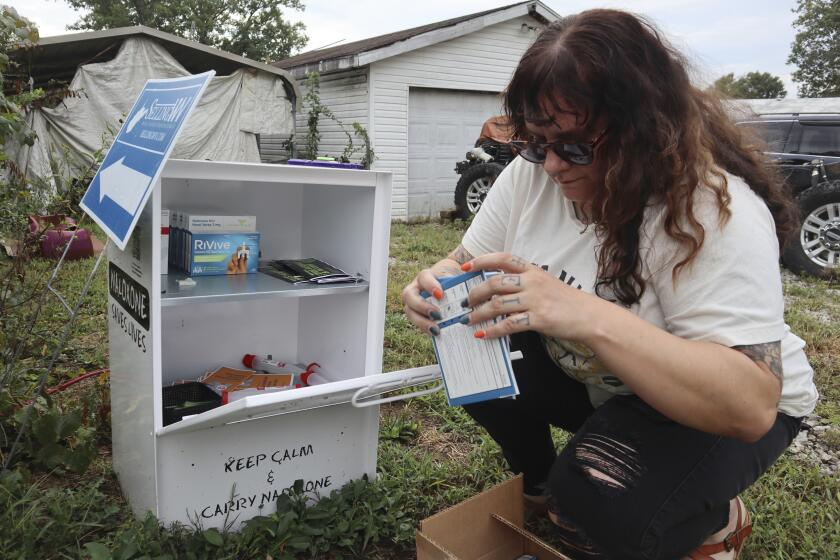Border Crossing Made Easy
Imagine placing your hand on a scanner or speaking into a computer to speed your way across the border.
Beam me across, Scotty.
Immigration officials are experimenting with biometrics and other identification systems--the stuff you read about in sci-fi books--to cut traffic delays and free up inspectors to focus on illegal immigrants and smugglers.
* On Interstate 5 at the San Clemente checkpoint, an experiment begins Monday on an automated lane that uses the same bar-code technology used to speed shoppers through supermarket checkout lines.
* In Scobey, Mont., on the Canadian border, testing is underway on what is being called the world’s first voice-activated port of entry, one that allows carefully screened residents to raise the gates by entering a personal identification number and uttering a previously recorded secret phrase into a telephone. A TV camera allows inspectors to monitor crossings from miles away.
* At airports in New York, Newark, N.J., and Toronto, low-risk travelers insert a card into a machine and place a hand in a scanner to clear immigration. A similar system is planned for Los Angeles International Airport this year.
* At the Otay Mesa border crossing near San Diego, cars equipped with small electronic devices known as transponders are avoiding waits of up to 45 minutes and zipping across the border in less than a minute.
And soon, motorists may be able to speed across the border simply by smiling into a camera or talking into a computer, both without getting out of their car.
Immigration officials have also looked at in-vehicle fingerprint readers but are focusing more on a facial recognition system because it does not require motorists to take their hands off the wheel.
It’s all part of a once futuristic technology of biometrics that uses the unique characteristics of the hand, voice, face and eyes for identification. Banks, for example, are experimenting with cameras that scan the iris as a way to fight misuse of ATM cards and personal identification numbers.
In all of the high-tech programs, drivers must be fingerprinted, photographed and undergo background checks. Permission to pass through automated checkpoints is granted only to travelers determined to be very low-risk. There also are random spot checks of motorists using the automated lanes.
U.S. authorities got the idea for biometrics on a trip to Amsterdam, where a fingerprint machine is used to speed travelers through immigration.
At Otay Mesa, 2,500 drivers are using transponders--similar to the kind used for automatic billing on the new toll roads--to avoid traffic jams.
As the car reaches the border, pictures of the driver and any registered passengers come up on a screen inside the inspector’s booth. Other information about the driver and the license plate and make of car also appears.
The driver then swipes a card through a machine, and if all is well, a green light comes on, a sign flashes “inspection completed,” and the gate goes up.
“What we’re doing is trying to take out the good people and put them in an expedited lane,” said Bruce Ward, assistant area port director for the San Diego ports of entry. “It gives us more time to deal with the higher risk people in the other lane.”
No illegal immigrants or drugs have been found in cars using the automated lane since the program began in late 1995.
Robert A. Mocny, assistant chief inspector of the U.S. Immigration and Naturalization Service in Washington, said that in order to sell the program to Congress, INS officials needed to guarantee that the automated lanes are more secure. “If you’re going to expedite certain people, you’d better be sure that you’re not letting people smuggle drugs or aliens,” he said.
A similar automated lane is planned for as early as this summer at San Ysidro, the world’s busiest land-border crossing, on the San Diego-Tijuana border. Eventually, other crossings along the Southwestern border will follow.
Officials are looking at testing a totally biometric lane at Otay Mesa, one that would use voice and facial recognition systems to identify and clear drivers.
Cameras would function as the eye of the inspector, automatically comparing the pictures of registered drivers with those in the computer. Drivers also would speak into handsets, which would verify their voice prints.
At San Clemente, cars will be screened just like a can of peas at the supermarket. Officials point out that the bar-coded window decals will be difficult to counterfeit.
Initially, pre-approved drivers given bar-coded window decals will need to slow down, and an agent will stand by to wave drivers through. But authorities hope in a year to add transponders to vehicles so they can go through without slowing down.
The systems have not been entirely without problems. At Kennedy International Airport in New York, no impostors or counterfeit cards have been detected. But authorities say the scanners have sometimes failed to permit approved travelers from passing through. They sometimes say, “It’s not really you when it is you,” Mocny said.
Richard Simon can be reached on the Internet at richard.simon@latimes.com
More to Read
Sign up for Essential California
The most important California stories and recommendations in your inbox every morning.
You may occasionally receive promotional content from the Los Angeles Times.











